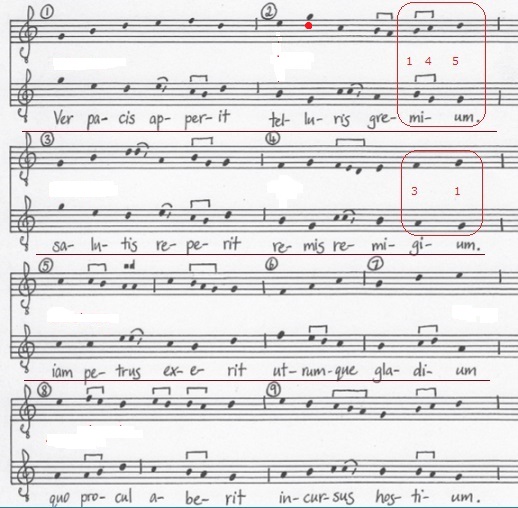| Ver pacis apperit telluris gremium |
壒妝僄僢僙僀偺儁乕僕傊栠傞
弶婜懡惡壒妝
St.儅乕僔儍儖妝攈傊
儗僆僫儞丂倁倝倓倕倰倳値倲傊
NotreDame school(condctus)傊
 http://teca.bmlonline.it/ImageViewer/servlet/ImageViewer?idr=TECA0000342136#page/649/mode/1up 乮c.f.320r)  Ver pacis pacis aperit telluris gremium / Salutis reperit Remis remigium / lam Petrus exerit utrumque gladium/ Quo procul aberit incursus hostium... In unum confluit totus fons gratie / Cuius ros imbuii rus conscientie / Rivum, quem genuit rigor lustitae / Flumen preterfluit misericordie 丂Payne偺嵟弶偺僇僥僑儕乕偼 嘆the polyphonic cantio group偱偁傝丄偦偺堦椺偼1179擭偵彂偐傟偨Ver pacis aperit偱偁傞丅乽 cantio 乿偼懡偔偺庬椶偺拞悽偺壧傪娷傓峀偄梡岅偱偁傞偑丄Payne偺偙偺梡岅偺巊梡偼丄摿偵AAB偺宍幃偺嶌昳傪巜偡丅13 Ver pacis aperit偼丄儊儕僗儅偺側偄僩儖償僃乕儖偺contrafact偱偁傝丄屻偺嶌昳偑儊儕僗儅彂朄偵傛傝懡偔偺徟揰傪摉偰偰偄傞偨傔偵丄Payne偼丄偙傟偑嵟傕弶婜偺僗僞僀儖偺conductus偺傂偲偮偱偁傞丄偲帵嵈偟偰偄傞丅Payne偼丄1200擭埲崀偵彂偐傟偨偙偺僗僞僀儖偺datable conductus傪1偮偩偗尒偄偩偟偨丅1224擭偵彂偐傟偨De rupta Rupecula偱偁傞丅14 Relationships between the Twelfth-Century Aquitanian Polyphonic Versus and Two-Part Conductus Repertories嶲徠 Ver pacis aperit was written in 1179 for the coronation of King Philip Augustus of France. Leo. The presence of the vernacular text by Blondel de Nesle suggests the possibility that this was written first as a trouvere song. Schrade, however, has compared the shape of the melody with that of the antiphon Unxerunt Salomonem, which was sung while the king was anointed, and has found that the conductus contains musical quotations from the antiphon. This, Schrade says, clearly shows that the creation of the conductus was closely linked with the coronation liturgy, and therefore could not have been created by Blondel as a secular work. Schrade suggests that Ver pacis aperit would likely have followed the performance of Unxerunt Salomonem, at the time when the king's insignia would have been brought forward. Although Schrade's explanation of the features of the text is convincing, the appearance of some notes from the antiphon in the conductus melody is not persuasive enough to conclude that the conductus version is earlier than Blondel's version; it is impossible to know which version of the work might be the original. Relationships between the Twelfth-Century Aquitanian Polyphonic Versus and Two-Part Conductus Repertories p106(PDF儁乕僕) written in 1179. The work also has a contrafactum text by the trouvere Blondel de Nesle: Ma joie me semont. Five manuscripts transmit this version of the work.. Another sub-group of conductus uses these intervals as well as the fourth. Ver pacis aperit, for example, has in its cadence in phrase 2 the progression of a unison moving to a fourth and then to a fifth. The rest of the cadences are the same as those in the Aquitanian cadential progressions, using only unisons, thirds, fifths and octaves as significant intervals. (摨彂p138) 尦棃丄cadence偵姰慡4搙傪梡偄傞椺偼彮側偄丄偲偄偆偙偲丅 The Organum Interval Group contains works in which unisons, fifths and octaves are the most important intervals. There are two conductus in this category: Ver pacis aperit, written in 1179, and Ave nobilis venerabilis Maria. These conductus may well have been written at an earlier time than those in the other two categories, or use intervals in a way that is associated with the earlier works. Fuller偵傛傞暘椶偱偼丄奺惡晹偺vertical側娭學偵傛傝丄 嘆The Organum Interval Group乮 contains works in which unisons, fifths and octaves are the most important intervals乯丂 嘇 Transitional Interval Group乮 an increasing use of the third and fourth乯 丂 嘊 Discant Interval Group乮 contains works in which the third is one of the most significant intervals.乯 偵暘偗傜傟傞丅 In Ver pacis aperit, unisons are the most common interval, followed by fifths. The number of signficant octaves and signficant fourths is the same, although there are six fourths also used as passing intervals. The next most common interval is the third; there are nine of these, and only three are significant intervals. Seconds and sixths are only used as passing intervals in this work. The fourth is treated as a secondary consonance in Ver pacis aperit. It is always found between two very strong intervals. It is not always used only as a passing interval, however. There are fourths that begin the second and fourth phrases, although if the intervals are taken in order, the first to second phrase has the progression 1-4-5, and the third to fourth phrase has 5-4-1, so the fourths are between two much more consonant intervals. Thirds are not used significantly in this work, and they do not appear at the beginnings and ends of phrases. Thirds most often are used as passing intervals, sometimes with seconds created by the use of stepwise motion. (摨彂p154)  http://www.diamm.ac.uk/jsp/Descriptions?op=SOURCE&sourceKey=919 |